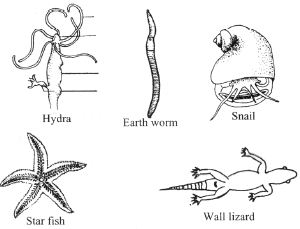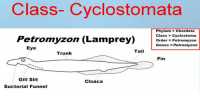Due to diversification among the animals, the zoologists have categorized the animal kingdom into the following criterions:
1. On the Basis of Shape and Size: Animals are grouped into two categories on the basis of their shapes and sizes, such as:
Microscopic Animal
a. Light Microscopic: These animals can be seen well with the help of the simple light microscope. Example: Amoeba, Hydra Cyclops Daphnia etc.
b. Large Animals: These are not microscopic. These can be seen by naked eyes. Innumerable small, medium, large and very large animals belong to this group. Example: Ant, Fly, Mosquito. Leech, Earthworm, Cockroach, Frog, Turtle, Lizard Snake, Crocodile, Dog, Cat, Goat, Cow, Bat, Whale, Man etc.

Fig: various type of symmetry
2. On the basis of Symmetry: Description of the relative proportion of the shape, structure, Size etc. of various organs of the animal body is called symmetry. The symmetry of animals is mainly of three types.
a. Asymmetry: Not capable of being halved in any plane, e.g. Amoeba, snail etc.
b. Bilateral Symmetry: Capable of being halved in one and only one plane, e.g. Cockroach, Lizard, Frog, Fish, Man etc.
c. Radial Symmetry: Capable of being halved in many planes, e.g. Hydra, Jelly fish, Star fish, etc.
3. On the basis of habitat: Animals are of different types such as:
a. Terrestrial: They live on land, e.g. Cockroach, Toad, Goat, Cow, Tiger, Man.
b. Aquatic: They live in water. Aquatic animals are of two types:
- Fresh water animal: Hydra, Singh, Kai, Frog, turtle, crocodile
- Marine animal: Lotia fish, Whale, Dolphin, Jellyfish, Shark, Starfish and Coral.
c. Flying: This animals can fly in the sky, e.g. Butterti.y, Bats and various species of birds
d. Tree-living Or Arboreal: They live on trees, e.g. Tree frog, Python, various species of Monkeys, Lemur and Leopard.
e. Desert dweller: They are animals of the desert, e.g. Camel, Dumba etc.
f. Boreal: Rat, Fox, Platypus, some species of snakes, Earth worms etc.
g. Polar: Some animals live in the Polar Regions, e.g. White bear, Antelope and Penguin.
h. Forest dweller: Tiger, Bear, Monkey, Deer, Peacock, various species of Snakes and Birds, Boar, wild Buffalo etc. They live in the deep forest.
i. Mountain dweller: Gayal, Mountain goat, Elephant etc, are animals living in mountain areas.
4. On the basis of habits: On the basis of habits animals are of two types; mainly:
a. Diurnal: They are active during day timer e.g. Deer, Squirrel, Cow, Hone, Duck, Hen, Vulture, Butterflies, Hoppers, Eagle and King stock.
b. Nocturnal: These animals are active during night time, e.g. Tiger, Fox, Owl, Moths, Shrew, etc.
5. On the basis of feeding habits animals are mainly of three types:
a. Herbivorous: These animals eat grass or other plant materials, e.g. Goat, Sheep, Cattle, Elephant, Horse, Rabbit, Guinea pig, etc.
b. Carnivorous: They are generally predacious and feed on animals, e.g. Tiger, Lion, Jackal, Vulture, Hawk, Hyena, etc.
c. Omnivorous: Animals of this category eat all kinds of food, e.g. Cockroach, Crow, domestic Dog, Cat and Man.
6. On the basis of nutrition:
Holozoic or heterotrophic or zootrophic: For nutrition, they depend upon plants or animals, because they cannot prepare their own food. Heterotrophic animals are again mainly of three types:
- Scavengers: They get their food from dead plants and animals, e.g. Cockroach, Crow, Vulture, Hyena etc.
- Parasites: They take nutrients from other organisms i.e. the host’s body. They are smaller in size than the hosts. They live outside or inside the host body e.g. Roundworm is an internal parasite of the human body and pediculus is an external parasite.
- Predators: They are generally bigger in size than their prey animals. They kill their hunts and eat their flesh e.g. Tiger, Lion, Jackal, Wolf, etc.












